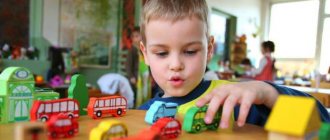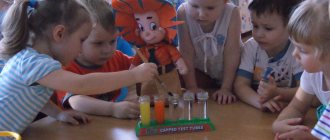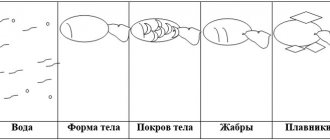Organization of educational and research activities in preschool educational institutions
All the guys are interested in everything in the world,
Because why are inquisitive children
And they bring their why questions to kindergarten,
Because the teacher will be happy to answer them.
* * *
Currently, the latest developments, technologies, and methods are being formed and successfully applied in the preschool education system, which make it possible to raise the level of preschool education to a higher and higher quality level. One of such effective methods of understanding the patterns and phenomena of the surrounding world is cognitive research activity .
The theoretical basis of the work was the research of Academician Nikolai Nikolaevich Poddyakov, Doctor of Pedagogical Sciences Olga Vitalievna Dybina, Raisa Mikhailovna Chumicheva, which helped to clarify the essence of children's experimentation as a form of search activity , its structure and significance in the development of the child’s personality. N. N. Poddyakov claims that children's experimentation claims to be the leading activity during the period of preschool development of the child. Its main proof is the fact that the activity of experimentation permeates all spheres of children's life, including play, which arises much later than the activity of experimentation and is built by the children themselves, which contributes to their self-development.
So, the key word was sounded - experiment. What is necessary for its successful organization . Our experiment is based on three main components, “three pillars”
.
The first component answers the question “Who?”
.
Dear colleagues, who is needed to organize educational and research activities ? Of course it's a child. After all, educational and research activities for children are a door to a magical land of the unknown , where there are mysteries and, most importantly, new discoveries are hidden behind every riddle.
So, what’s next, and then we need “scenery”
.
The question here is “What?”
and the second integral component of experimental detail appears - this is...equipment. It must be safe, universal and accessible to use.
And now my children and I are ready to completely immerse ourselves in science, in search of answers to a variety of questions.
Video
- Why do you need ears? - the teacher asks the girl.
- To see everything.
Of course, from the height of his life experience, the teacher immediately wants to correct the mistake and give the child a ready-made correct answer to the question. In the field of exact sciences, we think this would be the correct model of behavior, but if we consider cognitive and research activities in kindergarten, the key to success here lies elsewhere. We do not break the thread of reasoning, but rather cling to it. And we come to the third component – the object of research. The most important question should be asked here... What do you think is the key question in the field of cognition ? Any suggestions? Right, WHY? Let's ask this question together to our girl Polina, three or four... WHY! Indeed, why ears, because that’s what eyes are for!
Video
- So that’s how it is... But if there are no ears, then the hat will slide over my eyes, and I won’t see anything.
It is necessary to understand the main thing: the consciousness of a preschool child is free from stereotypes. It is quite natural that preschool children have little knowledge of what science with a capital S is, however, they, like no one else in the world, are able to look at seemingly ordinary things from a completely new angle. It is at this moment that we provide the child with the opportunity to test his guesses in practice - this will be the best answer to all the children’s whys.
Children study, and we observe and think. Often the idea of experimental activity is very superficial ; many people imagine “that something should be bubbling, smoking, or at least bubbling”
.
We once thought so too. Chemistry can explain many phenomena in our lives and it is not at all necessary that “something just smokes
. So it is with experiments. What is important is not the spectacularity of the action taking place, but the meaning of the work done and the correctly formulated conclusion. It is very important that it is adapted for children's consciousness. Should the child understand what he is doing? what is he doing for? and what he finally found out!
The relevance of our chosen topic is confirmed by the fact that on the basis of the Kommunarsky kindergarten “Solnyshko”
There is a municipal experimental site on the topic: “Environmental education of preschool children through the introduction of research technology
. ”
The goal of our work is to create conditions for the development of children’s cognitive activity , curiosity, the need for children’s mental impressions, the desire for independent knowledge and reflection .
The goal identified the following tasks:
— expand children’s understanding of the world around them through familiarization with basic physical properties and phenomena;
- develop coherent speech, encourage reasoning, argumentation, use speech - evidence;
- involve parents in joint experimentation activities
The integrity of cognitive and research activities is based on the complex principle of building continuity of the process and provides for the solution of program problems in the joint activities of the teacher , children and parents.
Expediency. Cognitive and research activities contribute to the full enjoyment of preschool childhood, allow individualization of the pedagogical process, and immerse the child in an atmosphere of creativity, independence and initiative.
Creation. Cognitive and research activities in kindergarten can be organized by teachers in the form of observations, practical experiments with elements of experimentation, play activity, collecting, designing, and this list is not complete, so preschool teachers can safely implement a creative search in the direction, carefully monitoring reactions and children's level of interest.
Let's consider the technology of experimentation through the prism of educational areas of the Federal State Educational Standard for Preschool Education:
SOCIAL-COMMUNICATION DEVELOPMENT
(interaction with peers and adults. For a successful experiment, everyone needs to agree on the upcoming work and distribute responsibilities.)
COGNITIVE DEVELOPMENT (development of imagination and creative activity, there is a need to perform operations of analysis and synthesis, comparison and classification.)
SPEECH DEVELOPMENT (enrichment of active vocabulary. There is a need to tell others about your new experience, about what you saw.)
ARTISTIC AND AESTHETIC DEVELOPMENT (experiments and experiments involve the implementation of independent creative activities of children - visual, constructive and model.)
PHYSICAL DEVELOPMENT (children improve physical qualities such as coordination and coordination of movements, develop large and fine motor skills.)
The implementation of this technology involves the use of research and activity approaches .
The research approach underlies learning, in which the child is placed in a situation where he himself masters the concepts and approach to solving problems in the process of cognition , to a greater or lesser extent, organized by the teacher .
The activity approach explains the process of active research assimilation of social experience through motivational, goal-oriented problem solving. This activity is not set by adults in advance in the form of one scheme or another; it is built by the preschooler himself as he receives new information about the object.
Based on the research of Olga Vitalievna Dybina and Raisa Mikhailovna Chumicheva, conceptual principles were substantiated that ensure the effectiveness of the implementation of children's experimentation technology:
-stimulating the experimental activity of a preschooler . The stimulating factors are the situation of choice, the problem.
-The principle of freedom and independence. Providing the child with an independent determination of attitude towards the environment, independent research, choice of goals and application of the result.
-The principle of activity. Allows children to recreate adult forms of activity (experiment, experience)
.
At the first stage of working with children, children’s ideas about the properties and qualities of materials were clarified, we introduced children to some phenomena and objects of inanimate and living nature, preschoolers were involved in the transformation of problem situations, and their interest in experimentation was stimulated. When interacting with the child, the process was structured as follows: knowledge was not communicated in a ready-made form, but assistance was provided to the child in obtaining it independently. Having carried out a small experiment, the child thought through the stages of its implementation, and together with him the necessary actions were carried out. Gradually, they began to involve children in predicting the results of their actions: “What will happen if we blow on a dandelion?”
. At this stage, children began to practically master the properties and qualities of various materials, children actively participated in the study and transformation of various problem situations, and became familiar with ways to record the results obtained.
We used the following problem situations: “Let’s find out what kind of water it is?”
,
“Where did the water go?”
,
“Where does water come from?”
,
“What properties?”
,
“To see the air you need to catch it,”
etc.
During the activity, children were helped to identify the sequence of actions and reflect them in speech when answering the questions: What did we do? What did we get? Why?. The assumptions and results of the experiment were compared, and conclusions were drawn based on guiding questions: What were we thinking? What happened? Why? The children learned to find similarities and differences between objects. At the end of the experiments, we discussed with the children which of them had learned something new.
Children actively participated in the proposed experiments, willingly acted independently with objects, identifying their features (for example, the ability of a magnifying glass to “enlarge”
and
“shrink”
objects, etc.). They showed a desire to experiment at home: to study various household items, their effects (they froze water in the refrigerator, put ice on the radiator, etc., this was clarified in conversations with parents and children. We also conduct experiments with plants:
“In what conditions does onion grow best?” “Growing seeds in and without water,”
etc.
Effectiveness. At this stage of work on the stated topic, we can talk about intermediate results:
-experimental research activities arouse great interest among children,
-helps the child experiment and synthesize acquired knowledge;
- build a relationship between the teacher, parents, and children of the group based on partnership;
-develop creativity, communication and cognitive skills .
To form the cognitive activity of children in kindergarten, the following conditions were created:
-organization of a subject-spatial development environment: card files of experiments and experiences, a corner “Young Scientist”
,
“Ecological Corner”
, the library has been replenished with encyclopedic literature;
-involvement of parents: performing experiments at home.
The knowledge and skills obtained as a result of one’s own experimental search are much stronger and more reliable than those obtained through reproductive means.
Encouraging children's curiosity, quenching the thirst for knowledge of little “whys”
By directing their
cognitive activity into experimental activities, we contribute to knowledge of the world around us , awareness of its diversity and help determine their own place in it.
In conclusion, I would like to note that experimental activities also solve such an important problem as continuity between preschool education and school. After all, the level of cognitive activity of children is a necessary component of educational activity . And the knowledge and skills children acquired in the field of experimentation will be relevant and in demand during training and are certainly the key to high achievements of my students in the future.
The concept of activity and its structure
Man and human society cannot exist without activity. In the course of his activities, a person transforms the world around him, changes reality, including himself and the entire society, and also satisfies his needs.
Human activity is fundamentally different from animal activity. First of all, a person sets goals for himself, he has a conscious motive, he chooses from the means and methods available to him those that will be the most rational to achieve his goal. Animals base their activity on instincts, they have no conscious goal, they also do not choose methods and means, they do not create new tools, all their means have already been created by nature. Human activity is inherently systematic and productive, i.e. it creates something that did not previously exist in the natural environment. Animals are not capable of creating something new; their activity is always an adaptation to the external environment. And if the activity of an animal is genetically inherent in it, then in a person it appears only in the course of learning and development in society, in the process of socialization. Human activity is constantly becoming more complex as society develops, so it is socio-historical in nature.
Are you an expert in this subject area? We invite you to become the author of the Directory Working Conditions
The structure of activity is built in the following chain:
Object => subject => motive => goal => means => process => result
- Object is what the activity is aimed at;
- The subject is the one who performs the action;
- Motive is what motivates a person to perform an action;
- Goal is a conscious image of the result to which the activity is aimed;
- Means – methods, methods and objects with which you can achieve a goal;
- Process – the sequence of actions leading to the achievement of a goal;
- Result is the result of an activity, obtaining a final product.
Practical activities
Among the various activities, practical activities are of great importance. It is a way of including a person in the world around him and actively influencing him in order to transform existing objects and create new ones. Through practical activity, a person understands his capabilities through experience, studies the world around him, and finds his place in it. As a result, his inner world changes, his spiritual life is filled.
Finished works on a similar topic
Coursework The essence of practical, cognitive, evaluative activity 440 ₽ Abstract The essence of practical, cognitive, evaluative activity 230 ₽ Examination The essence of practical, cognitive, evaluative activity 250 ₽
Receive completed work or specialist advice on your educational project Find out the cost
Practice is realized in the course of subject-object and subject-subject relations; it is always of a social nature. It presupposes the existence of a certain culture of communication as a condition for its existence. In addition to the active transformation of the external environment, practical activity presupposes the communication of people in the course of their work, as well as a set of values, norms, and rules that ensure the purposeful nature of the activity.
The following forms of practical activity are distinguished:
- production practice - the production of material objects, this type of activity underlies all human life;
- technical activity - the transformation of certain devices created by man (artifacts), an element of the productive forces that determines the nature and method of social production;
- social practice - transformation of the social environment, social relations, can be revolutionary in nature;
- science is a special form of activity that turns into a direct productive force that also controls social processes.
Note 1
Thus, practical activity can be aimed not only at transforming material objects, but also at changing social relations and social practice.
The most important function of practical activity is the ability to test our knowledge and resolve the question of truth. Only through practice can truth be separated from error. However, practice opportunities are limited.
Cognitive activity
Gaining knowledge about the world around us occurs during the deployment of cognitive activity. It is realized at the sensory and rational levels, i.e. First, the processes of perception, sensation and ideas occur, and then, on their basis, concepts, judgments and inferences are built. The structure of cognitive activity does not differ from the general structure. The result is knowledge in three forms - practical, spiritual-practical and theoretical.
Cognitive activity involves an active and purposeful search for knowledge. In philosophy, this direction corresponds to epistemology or the theory of knowledge. Epistemology began in the ancient world. Democritus also identified dark (sensual) and true (rational) knowledge. Disputes about the knowability of the world, the limits of knowledge and the truth of acquired knowledge have been ongoing throughout the centuries-old history of mankind. The cognition of the world was closely associated with practical activity and the ability to experimentally verify the result. However, a direction emerged in the history of philosophy that denied the knowability of the world - agnosticism, which believed that a person would not be able to know the world because his very cognitive abilities were limited.
Note 2
Scientific knowledge is particularly prominent in human cognitive activity. Its main task is to discover the objective laws of reality, obtain the truth, and be practice-oriented.



